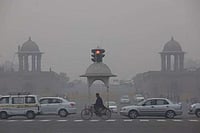India has surpassed China by becoming the world’s most populous country, according to the United Nations data.
The NDTV report mentioning UN estimates, said India's population is 142.86 crore against China's 142.57 crore.
“This is the first time that India has topped the UN list of most populous countries since it started collecting population data in 1950,” the report said.
It also stated population in China went down last year for the first time since 1960.
In 1960 in China, millions had starved to death under the disastrous agricultural policies of former Chinese leader Mao Zedong.
China also faces a looming demographic decline as birth rates plunge and its workforce ages.
It said several regions in China have also announced plans to boost birth rates—but official efforts have so far failed to reverse the decline.
Where does India stand with its population growth?
Earlier, the UN Population Fund (UNFPA), in a special graphic to mark the global population reaching eight billion, had said Asia and Africa have driven much of this growth and are expected to drive the next billion by 2037, while Europe's contribution will be negative due to the declining population.
“India, the largest contributor to the 8 billion (177 million) will surpass China, which was the second largest contributor (73 million) and whose contribution to the next billion will be negative, as the world's most populous nation by 2023,” UNFPA had said.
India is projected to have a population of 1.668 billion in 2050, ahead of China’s 1.317 billion people by the middle of the century.
India's population is set to rise to 1.515 billion in 2030, from 1.417 billion in 2022. China's population, by contrast, is expected to fall slightly from 1.426 billion to 1.416 billion over the same period.
According to UNFPA estimates, 68 per cent of India’s population is between 15-64 years old in 2022, while people aged 65 and older were seven per cent of the population.
China and India, with more than 1.4 billion each, accounted for most of the population in these two regions.
India’s decreasing TFR
The report had said that India’s population is set to surpass China, the numbers should not be coming as a shock, experts believe.
A report by India Spend quoted Poonam Muttreja, executive director of the Population Foundation of India, saying that 31 states and Union Territories in India have reached the [population] replacement level of 2.1.
This is also known as the Total Fertility Rate (TFR), which means the average number of children a woman of child-bearing age must have. This of course means, that a woman must have 2 children and the extra, 01, indicates children who die in infancy or women who die before childbirth. A TFR of 2.1 will help in stabilising the population.
Three years ago, the National Family Health Survey (NFHS)-4 found India’s TFR had already reached 2.2. Most Indian states had already achieved or were below 2.1 TFR.
However, UNFPA notes that India’s TFR has declined from 2.2 to 2.0 at the national level. The country reached the national replacement level of fertility in 2020, but this replacement level is not even across all of India.
While 31 States and Union Territories with 69.7% of the country’s population have reached below the replacement rate of 2.1, TFR is above the national average in states like Bihar, Meghalaya, Manipur, Uttar Pradesh, Jharkhand and Madhya Pradesh.
India’s National Programme for Family Planning was launched way back in 1952 and the National Population Policy in 2000. UNFPA concludes, “This indicates significant improvements in access to family planning-related information and services. In summary, it shows that India’s national population policies and health systems are working.”
The main reasons for the decline in fertility include an increase in the adoption of modern family planning methods and a reduction in the unmet need for family planning.
Further with the increasing marriage age, fertility has declined although one in every five children gets married below the legal age.
The way forward is to pursue Sustainable Development Growth (SDG) with a human rights approach with special emphasis on women and girls by making sure the availability of information regarding sexual and reproductive health and rights and facilities like contraceptives and maternal healthcare, according to an Outlook India report.
Further, Poonam Muttreja says, “Going forward, our focus should be on providing women of all communities access to family planning services, comprehensive sexuality education to adolescents, and changing regressive social norms that compromise the reproductive autonomy of women.”
India has no recent official data on how many people it has because it has not conducted a census since 2011.
India's once in a decade census was due to be held in 2021 but was delayed due to the coronavirus pandemic.






















.png?w=200&auto=format%2Ccompress&fit=max)



